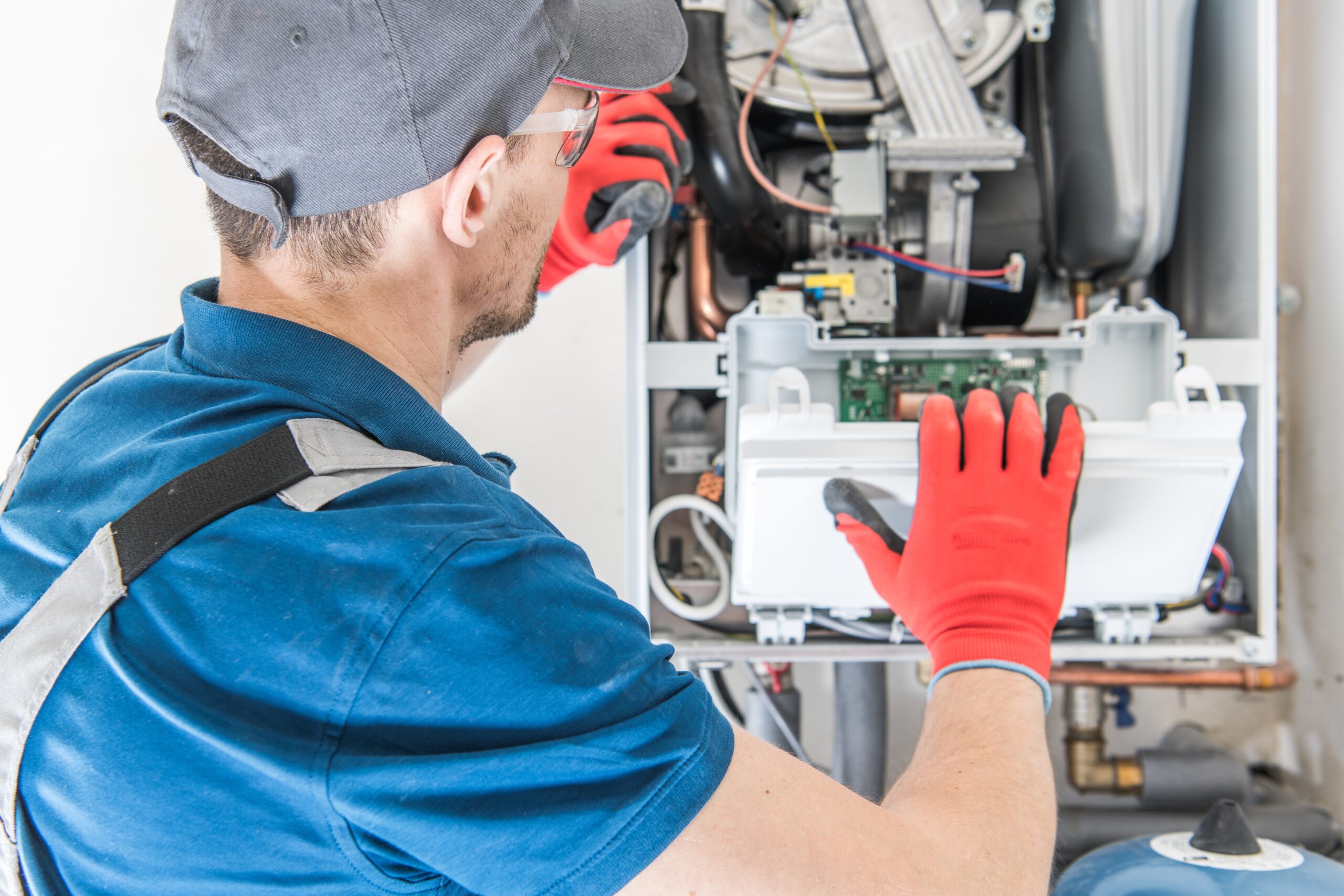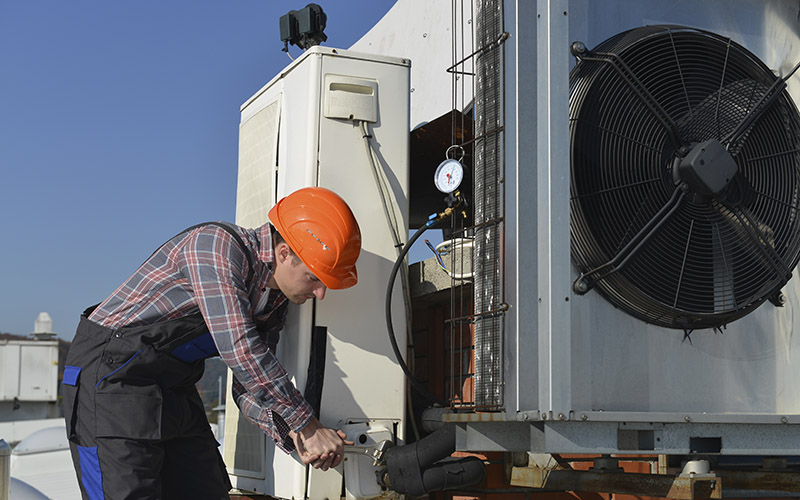How a Heatpump and Furnace Job With Each Other to Optimize Your Home's Home heating Efficiency
Understanding just how a heat pump and furnace collaborate is vital for homeowners seeking effective heating remedies. Each system has its toughness, supplying a balanced approach to home convenience. The heatpump masters modest temperatures, while the furnace delivers fast heat during extreme cold. This harmony not only minimizes energy costs but also improves the life-span of both home appliances. What aspects affect this cooperation, and just how can home owners maximize their advantages?
Recognizing Warmth Pumps: How They Function
Many individuals might be unknown with their internal workings, warm pumps play an essential function in modern-day home heating systems. These devices operate by transferring heat from one place to an additional, utilizing the concepts of thermodynamics. In colder months, a heat pump extracts heat from the outside air, ground, or water, and transfers it inside to heat the home. Conversely, during warmer months, it can reverse the procedure, serving as an air conditioning unit by getting rid of heat from inside to the outside.Heat pumps include an evaporator, expansion, compressor, and condenser shutoff. The refrigerant within the system takes in warm as it vaporizes at low temperature levels and pressures. The compressor then increases the pressure and temperature of the refrigerant, enabling it to release warmth as it condenses. This efficient procedure can significantly minimize energy consumption compared to traditional heating techniques, making heatpump a sustainable option for environment control in homes.
The Function of Heating Systems in Home Heating
Heaters play a necessary duty in home heating by giving a reliable resource of warmth throughout the cooler months. They run by generating heat through burning or electric resistance, distributing it throughout the home through ducts or glowing systems. The effectiveness of a heater is frequently determined by its Annual Fuel Use Effectiveness (AFUE) ranking, which suggests exactly how successfully the system transforms fuel right into heat.Furnaces can use various power sources, including all-natural gas, oil, electrical power, or gas, enabling home owners to choose one of the most appropriate option for their needs. Unlike heatpump, which might struggle in extreme cold, furnaces preserve constant efficiency, making sure that interior temperature levels remain comfy no matter exterior conditions. In addition, modern-day heaters often come furnished with innovative technology, such as wise thermostats and variable-speed blowers, enhancing their effectiveness and responsiveness. This versatility makes heating systems a vital component in all-encompassing home heating methods.

Benefits of Using Both Solutions Together
Incorporating the toughness of both heating systems and heat pumps can bring about a more effective and efficient home heating solution. Using both systems permits house owners to capitalize on the heatpump's power effectiveness during milder temperature levels while depending on the heater for more extreme cold conditions. This double method can considerably decrease energy costs, as warmth pumps take in less power than conventional heating approaches when temperatures are moderate.Additionally, using both systems with each other can improve comfort degrees in the home. Warmth pumps can give regular, even heating, while heating systems can promptly elevate ambient temperature levels when required. Moreover, the combination of both systems can extend the life-span of tools by reducing damage on each system, as they share the workload. Eventually, property owners can enjoy a balanced, economical heating solution that adjusts flawlessly to varying climate problems, making sure a warm and welcoming home throughout the cold weather.
How Heat Pumps and Furnaces Enhance Each Other
When homeowners integrate heatpump and heaters, they create a complementary heater that makes the most of effectiveness and convenience. Warm pumps operate by moving warmth from the outside air or ground, making them highly effective in modest environments. They succeed during milder temperature levels, supplying cost-effective home heating. On the other hand, heaters produce warm via combustion or electrical resistance, supplying strong, instant warmth during extreme cold conditions.The mix of these two systems permits vibrant adjustments based on temperature level changes. During warmer months or milder wintertime days, the heat pump can take the lead, conserving energy and reducing costs. As temperatures drop, the heater can perfectly involve, making sure consistent warmth throughout the home. This synergy not only maximizes power usage but also improves the life expectancy of both systems, as each unit runs within its suitable performance array. With each other, they develop a balanced atmosphere that adapts to differing environment needs.
Maximizing Performance: Tips for Homeowners
Home owners can improve their heating efficiency with several practical approaches. Establishing a routine maintenance timetable, incorporating smart thermostat innovation, and carrying out reliable insulation and securing options are essential actions. These actions not just enhance comfort but additionally reduce power costs.
Regular Upkeep Schedule
To guarantee optimal heating effectiveness, developing a routine upkeep timetable is essential for any type of home. Homeowners need to focus on regular assessments of both heat pumps and heaters to identify peak performance. This includes transforming air filters each to three months, as clogged up filters can considerably reduce effectiveness. important site In addition, scheduling specialist upkeep a minimum of yearly enables technicians to determine and attend to possible problems prior to they escalate. Home owners should additionally clean up the heatpump's outdoor unit to protect against debris buildup that can prevent air movement. By sticking to a routine upkeep routine, property owners not only enhance their furnace' effectiveness however likewise expand their life-span, resulting in greater convenience and reduced energy prices throughout the chillier months.
Smart Thermostat Integration
Integrating a clever thermostat right into a home heating unit can significantly enhance energy performance, especially as it permits specific control over temperature level settings. These gadgets can learn the home owner's schedule and choices, instantly readjusting the temperature to maximize convenience while lessening power use. For circumstances, they can reduce home heating throughout times when the home is vacant, reducing unneeded usage. Several wise thermostats also give real-time power usage information, enabling homeowners to make educated decisions regarding their heating practices. Additionally, remote access by means of smartphone apps permits individuals to readjust settings from anywhere, making sure the home is warm upon return. Generally, wise thermostat combination not only boosts comfort yet substantially adds to power savings and effectiveness.
Insulation and Securing Solutions
Smart thermostats play a crucial duty in energy effectiveness, yet their effectiveness can be greatly improved by correct insulation and sealing services. Home owners must focus on insulating attic rooms, floorings, and wall surfaces to lessen heat loss. High-grade insulation materials, such as spray foam or fiberglass, can significantly enhance thermal resistance. Additionally, sealing gaps around ducts, doors, and windows protects against cool air seepage and warmth retreat. Weatherstripping and caulking are efficient approaches for addressing these leaks - heat pump service. Routine inspections for air leaks, in addition to the use of blower door tests, can aid recognize trouble locations. By purchasing insulation and securing, property owners can optimize the performance of their home heating systems, inevitably leading to reduced energy consumption and lower energy expenses
Typical Myths Concerning Warm Pumps and Furnaces
What false impressions border warm pumps and heating systems? Lots of individuals mistakenly think that heat pumps are ineffective in colder environments. In truth, modern heatpump are designed to run effectively even in reduced temperatures, giving dependable home heating throughout winter. Another usual misconception is that heating systems are always extra efficient than warm pumps. Nonetheless, this relies on the details power resources and performance scores of the devices in inquiry. Some might also assume that utilizing both systems at the same time is unneeded, however as a matter of fact, this mix can maximize home heating efficiency, specifically throughout extreme climate condition. Furthermore, people commonly presume that warmth pumps require consistent maintenance, when actually, they have comparable upkeep needs to typical heating systems. By disproving these myths, homeowners can make even more enlightened decisions regarding their home heating options, eventually leading to enhanced convenience and power effectiveness in their homes.
Upkeep Factors To Consider for Combined Systems

Often Asked Inquiries
Can Heat Pumps Work Properly in Extremely Cold Climates?
Heat pumps can struggle in very cool climates due to decreased efficiency and heat extraction restrictions. Developments in technology have actually led to versions made for better efficiency in such conditions, improving their practicality in severe environments.
How Much Time Do Warmth Pumps and Furnaces Typically Last?
Warmth pumps usually last 15 to two decades, while heaters have a life-span of 15 to 30 years. Routine maintenance can prolong their long life, making sure efficient procedure and decreasing the demand for premature substitutes.

What Is the Typical Price of Setting Up Both Systems?
The ordinary expense of installing both a warm pump and a furnace usually varies in between $5,000 to $10,000 - heat pump service. Variables affecting this cost include system size, setup complexity, and regional labor prices
Are There Tax Rewards for Making Use Of Energy-Efficient Home Heating Systems?
Many property owners ask about tax obligation incentives for energy-efficient furnace. Various federal and state programs typically offer rebates or debts, encouraging the adoption of lasting technologies to reduce power intake and promote ecological responsibility.
Exactly how Do I Choose the Right Size Heatpump and Heating System?
Selecting the best size warm pump and heater involves computing the home's square footage, considering insulation high quality, and evaluating regional climate. Consulting an expert can assure optimal system efficiency and power performance based on certain requirements. furnace replacement. Recognizing how a heat pump and furnace work together is crucial for home owners looking for reliable home heating options. In cooler months, a warm pump essences warm from the outdoors air, ground, or water, and transfers it indoors to heat the living space. When home owners incorporate warmth pumps and heaters, they create a corresponding home heating system that takes full advantage my site of performance and convenience. Warmth pumps operate by transferring warmth from the outside air or ground, making them extremely effective in moderate climates. Warmth pumps can battle in incredibly chilly environments due to minimized performance and warmth extraction limitations